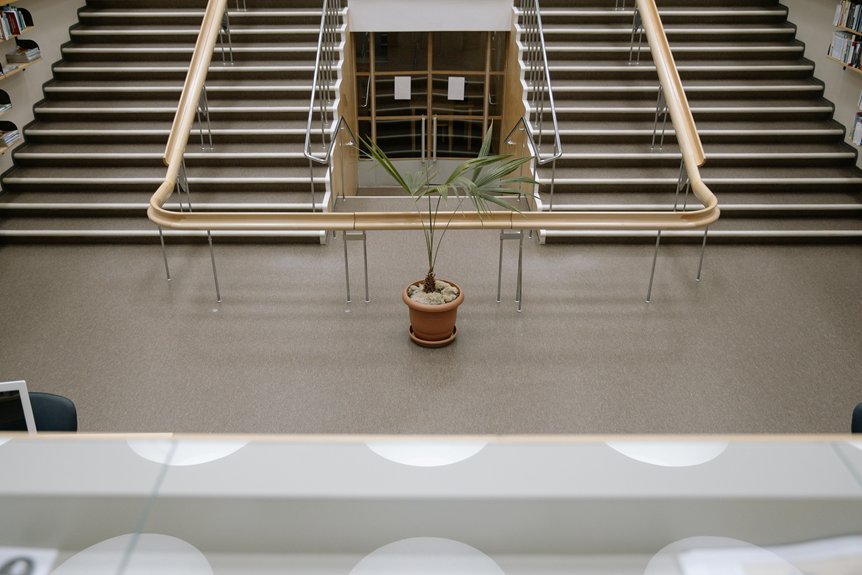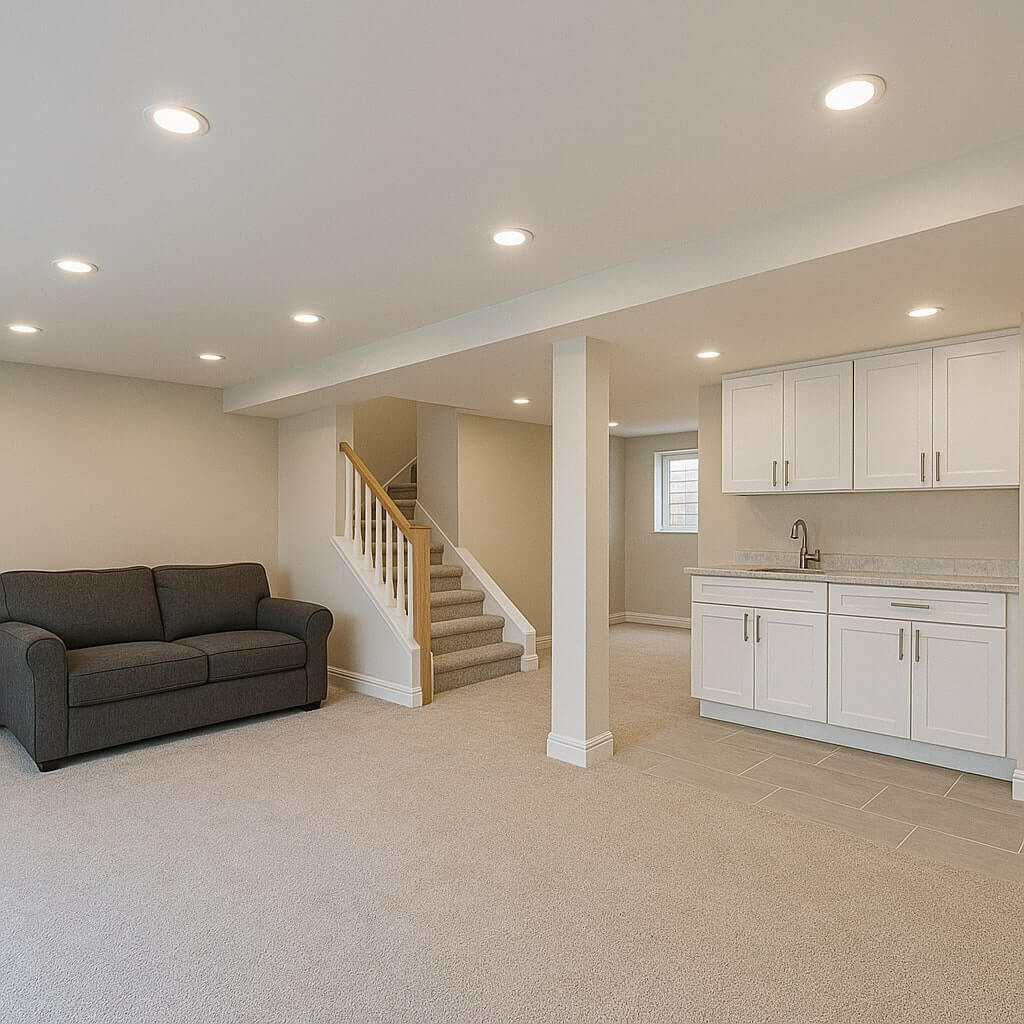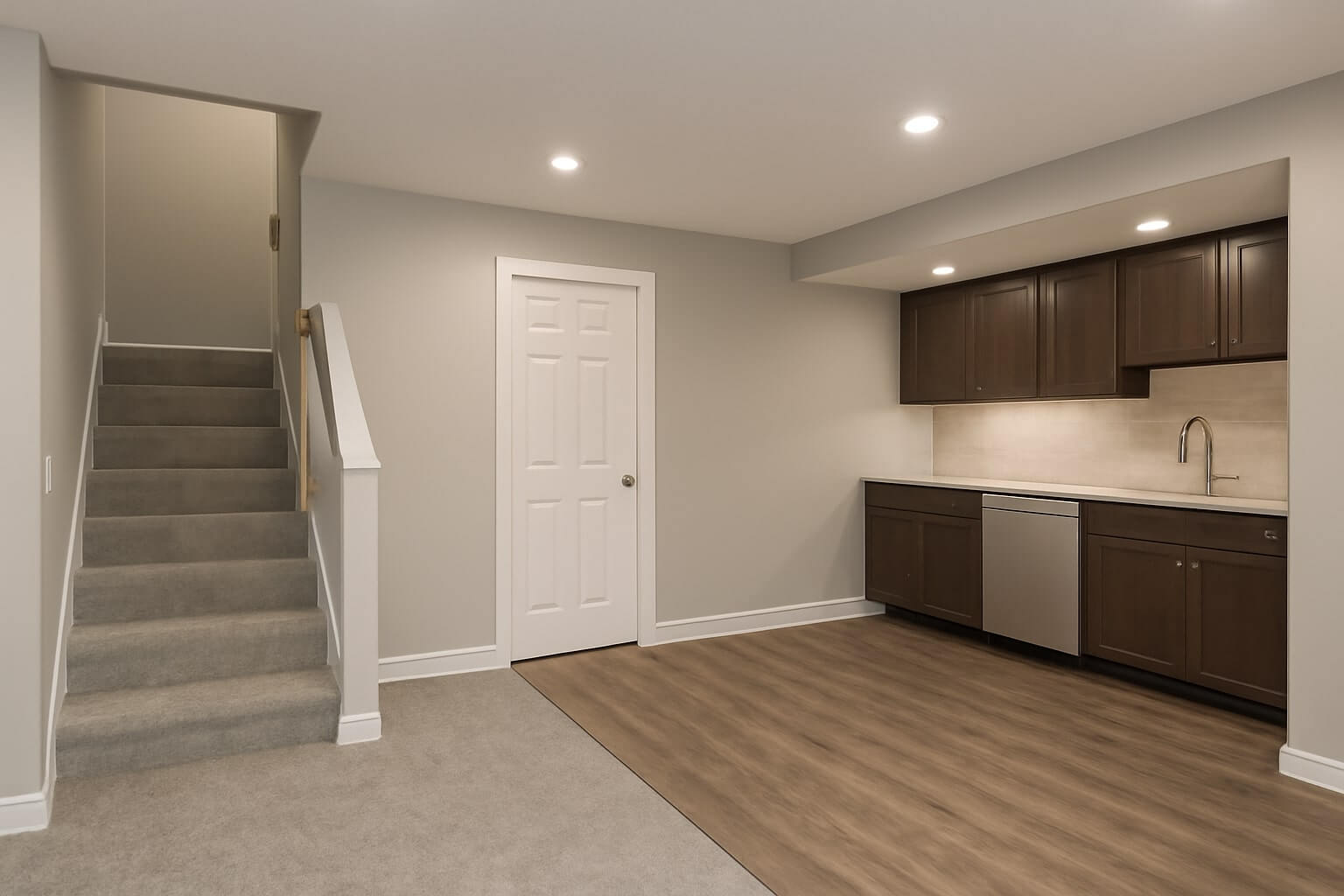If you’re considering a basement remodel, there are essential steps to follow for a successful DIY project. Start by evaluating your space and defining your goals, as this will set the foundation for your entire remodel. Next, think about your budget and timeline to keep everything on track. Understanding the necessary permits and regulations is also vital. Ready to explore the details of each step? Let’s get started.
Key Takeaways
- Assess the basement space, measuring dimensions and noting any structural issues before defining your remodel goals.
- Establish a realistic budget and timeline, accounting for materials, labor, and unexpected expenses.
- Research and obtain necessary permits to ensure compliance with local building codes and regulations.
- Plan the layout carefully, creating zones for different activities while ensuring smooth flow and connectivity.
- Execute the remodel step-by-step, starting with structural work, followed by electrical, plumbing, and finishing touches like flooring and lighting.
Assess Your Space and Define Your Goals

When it comes to remodeling your basement, it’s essential to first assess your space and define your goals.
Start with a thorough space evaluation; measure dimensions, note any structural elements, and identify potential issues like moisture or inadequate lighting.
Once you’ve gathered this information, it’s time for goal setting. Think about how you want to use the space—whether it’s a home theater, guest suite, or playroom.
Clearly defining your objectives will guide your decisions and help you prioritize features.
Establish a Budget and Timeline
Before you start your basement remodel, you need to establish a budget and timeline.
Determine the overall costs by considering materials, labor, and any unexpected expenses.
Then, set realistic completion dates to keep your project on track and avoid frustration.
Determine Overall Costs
Establishing a budget and timeline for your basement remodel is essential to avoid unexpected expenses and delays. Start by conducting a thorough cost estimation, factoring in labor, permits, and materials.
Research various suppliers to compare prices and guarantee you’re making the best choices for material selection. Remember to include a contingency fund for unforeseen costs, as this can help you stay within budget.
Break down your project into phases, assigning estimated costs and timelines to each. This structured approach keeps you organized and focused, making it easier to track progress and adjust as needed throughout the renovation.
Set Completion Dates
Setting completion dates for your basement remodel is essential to keep your project on track and within budget.
To achieve this, you need to set deadlines for each phase and prioritize tasks effectively.
Consider breaking down your project into manageable segments:
- Framing the walls and adding insulation
- Installing electrical and plumbing systems
- Choosing flooring and finishing touches
Obtain Necessary Permits and Check Regulations

Before you start your basement remodel, it’s essential to research local building codes to guarantee compliance.
You’ll need to apply for any required permits and understand the necessary inspections.
Staying on top of these tasks will help you avoid delays and potential fines during your project.
Research Local Building Codes
As you commence your basement remodel, understanding local building codes is essential to confirm your project complies with regulations and avoids costly delays.
Research local regulations, as they dictate building standards that secure safety and legality.
- Check ceiling heights to meet minimum requirements.
- Verify egress windows for proper emergency exits.
- Inspect electrical and plumbing codes to prevent hazards.
Familiarizing yourself with these aspects not only helps you avoid fines but also confirms your renovations are safe and functional.
Take the time to gather this information—your future self will thank you for it!
Apply for Required Permits
Having a solid understanding of local building codes paves the way for the next step: applying for the necessary permits. You’ll need to identify the specific permit types required for your remodel, which may include electrical, plumbing, or structural permits.
The application process typically involves submitting forms and paying fees. Check your local regulations to verify compliance. Here’s a quick reference table:
| Permit Type | Description |
|---|---|
| Electrical Permit | For wiring and electrical work |
| Plumbing Permit | For plumbing installations |
| Structural Permit | For changes to load-bearing walls |
| HVAC Permit | For heating and cooling systems |
| Occupancy Permit | For final approval to occupy |
Stay organized, and good luck!
Schedule Inspections Timely
Once you’ve secured the necessary permits, it’s essential to schedule inspections promptly to keep your basement remodel on track.
Timely inspections guarantee you meet local regulations and help avoid costly changes later. Use an inspection checklist to guide you through each phase and stay organized. Set schedule reminders to keep everything on your radar.
- Confirm electrical and plumbing work meets code
- Verify insulation and drywall installation
- Confirm safety features, like egress windows, are in place
Plan Your Layout and Design
Before diving into your basement remodel, it’s crucial to plan your layout and design carefully. Start by sketching out layout ideas that maximize space and functionality.
Consider creating separate zones for activities like lounging, working, or entertaining. Explore various design styles, such as modern, industrial, or cozy farmhouse, to find what resonates with you.
Think about the flow and how each area connects, ensuring easy movement throughout. Don’t forget to account for furniture placement and lighting to enhance the overall atmosphere.
A well-planned layout and design will set the foundation for a successful and enjoyable basement remodel.
Address Insulation and Moisture Control
As you move forward with your basement remodel, addressing insulation and moisture control is essential to guarantee a comfortable and durable space.
Start by selecting the right insulation types, such as fiberglass batts or spray foam, to keep your basement warm.
Choosing appropriate insulation, like fiberglass batts or spray foam, is crucial for maintaining warmth in your basement.
Next, install moisture barriers to prevent dampness and mold growth.
- A vapor barrier on concrete walls
- Insulated flooring to keep warmth in
- Sealed windows and doors to block drafts
Execute the Remodel Step-by-Step
Start your basement remodel by breaking it down into manageable steps to guarantee a smooth and efficient process.
First, gather design inspiration to visualize your space. Sketch out your layout, considering functionality and flow.
Next, tackle the structural elements like framing and drywall installation. Don’t forget to incorporate essential renovation tips, such as ensuring proper electrical and plumbing work is completed before moving forward.
Once the basics are done, focus on flooring and lighting to enhance the atmosphere.
Furnish and Decorate Your New Space

Once you’ve completed the essential renovations, it’s time to transform your basement into a functional and inviting space.
Start with your furniture selection, opting for pieces that fit your style and layout. Choose a cohesive color scheme that enhances the ambiance and ties the room together.
- A cozy sectional sofa for relaxation
- A stylish coffee table to anchor the space
- Colorful area rugs to add warmth and texture
These elements will create a welcoming atmosphere, making your basement a go-to spot for gatherings or quiet evenings.
Don’t forget to personalize with decor that reflects your personality!
Conclusion
By following these seven essential steps, you can transform your basement into a functional and inviting space. Start by defining your goals and planning carefully, then tackle each phase methodically. Don’t forget to address insulation and moisture control to guarantee long-lasting results. With a clear budget and timeline, you’ll stay on track and enjoy the process. Once the remodel is complete, furnish and decorate to make the space truly yours. Happy remodeling!



